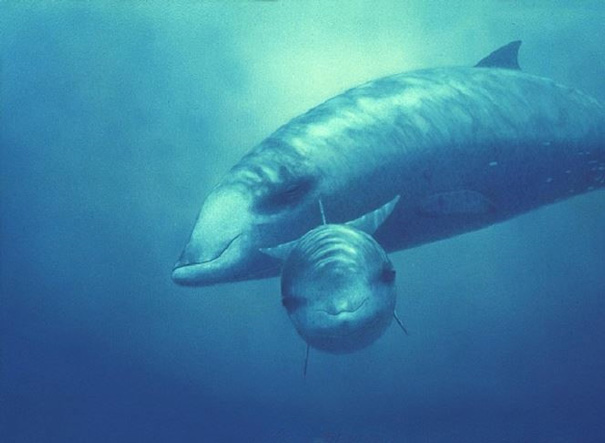The world's deepest diving mammals
Previously, the record of the world's deepest dive mammal belongs to the whale fish and runner-up is the statue. However, this record was changed in March 2014 when a group of scientists discovered another mammal.
1. Champion: Cuvier bighead whale

Two mothers of the fish caught in the mouth Cuvier.
Cascadia University researchers, led by Gregory Schorr, discovered the Cuvier bighead whale, capable of diving up to 2.99m (about 9816 ft). At the same time, the whale also broke the record of the "longest under water" of the previous existence of the statue. They are able to stay underwater for 2 hours and 18 minutes without needing to rise up to breathe.
Cuvier bighead whale has a scientific name, Ziphius cavirostris, which belongs to the Ziphiidae family, the Cetacea family. This is an aquatic mammal described by G. Cuvier in 1823. Although it is near the water surface, this species prefers water more than 1,000m deep. Cuvier's whale body is strong and cigar-shaped, they are usually about 6m long and weigh about 2,500kg.
2. Runner: sperm whale

Spermaceti.
With Gregory Schorr's research, sperm whales have been "robbed" out of the top of the world's deepest mammals. Even so, the depth they can dive to is still impressive, up to 2,250m.
Sperm fish can dive deep thanks to their ability to hold their breath for up to 90 minutes. Body structure helps sperm whales adapt well to sudden changes in water pressure. Flexible chests help them save oxygen and limit nitrogen absorption. In addition, whale blood has a high level of red blood cells, which helps them carry more oxygen.
3. Third prize: Sea statue

The statues are sunbathing under the beach.
Sea statues or sea elephants are the common way of calling an aquatic mammal that is 'trailer'. Among the marine species, the Pacific Ocean (Northern Elephant Seal) is the deepest diving ability. They can dive to a depth of 2.133m.
In the 1800s, the Pacific statue was placed on the brink of extinction when they were hunted to make lamp oil. Today, the number of animals is gradually restored thanks to new protection laws enacted.
- Russians conquer the deepest lake in the world
- Discover the mystery of the
- Biggest underwater walker and deepest dive in the world
- Chinese diving ship caught the
- American explorer dives into the deepest ocean trench in the world
- The kit supports deep diving
- Inventing diving lights from bottles
- Compact and flexible diving equipment
- Inside the world's deepest swimming pool
- Mariana Basin - What is the deepest place in the ocean?
- Japan develops the deepest dive ship in the world
- How does the 'hell well' deepest on the ground appear?
 Surprised: Fish that live in the dark ocean still see colors
Surprised: Fish that live in the dark ocean still see colors Japan suddenly caught the creature that caused the earthquake in the legend
Japan suddenly caught the creature that caused the earthquake in the legend A series of gray whale carcasses washed ashore on California's coast
A series of gray whale carcasses washed ashore on California's coast Compare the size of shark species in the world
Compare the size of shark species in the world